- A richly illustrated glimpse into the spiritual journey made by a million devotees each year to one of the world’s most iconic celebrations of Lord Murugan.
The Worship of Lord MURUGAN, God of war and victory,
has dual origins, both in Tamil folk traditions and the northern Sanskritic
traditions. Over time the worship of Skanda/Murugan developed with incredible
complexity, reaching millions of worshipers in South India from all social
backgrounds.
This article was first published in Hinduism Today.
Like other festivals honoring Lord Murugan, Thaipusam is celebrated not only in India and Sri Lanka but also in the Hindu diaspora—in Malaysia, Singapore, Mauritius, South Africa, Fiji and other Hindu Tamil communities. Each of these communities evolved in unique socio-political contexts, so their cultures are varied, but common elements are found in Murugan festivals worldwide.
Many of India’s major Murugan pilgrimage sites are linked to episodes from His legendary quest. The temple at Palani, long associated with systems of healing, is where Murugan is believed to have defeated the asura Idumban, conquered His inner passions and realized the Truth within.
Several festivals, major and minor, are held there
annually; Panguni Uttiram and Thaipusam attract hundreds of thousands of
pilgrims.
Tiruchendur, a major Murugan temple located on the seashore in the Tirunelveli District in the Bay of Bengal, is the mythical site of Murugan’s final battle with Surapadman. There the kavadi worship occurs at the festival of Chittrai Paruvum, held during the Tamil month of Chittrai (April-May).
At Thiruparankundram, near Madurai, where Murugan is
believed to have married Devvayanai, the Vaikasi Vishakam festival is held in
the Tamil month of Vaikasi (May-June).
Malaysia’s Hindu traditions and rituals have been greatly influenced by the waves of Indian migration which occurred during and after the British colonization of the area. In these newly formed communities Hinduism evolved in the absence of two key forces which played major roles in shaping Hinduism in South India: the prominent centers of religious learning and an Brahmin caste.
Instead, the Agamic culture was brought to Malaysia by
the Chettiar and Jaffna Tamil communities, who constructed major temples in the
main cities of British Malaya. At the same time, popular village Hinduism was
brought by those who arrived as indentured workers, and whose personal and community
practices differed according to their place of origin. In the many plantation
temples and roadside shrines, as well in most of the major temples, Lord
Murugan, in His multiple forms, was a strong presence.
With this widespread worship of Murugan, the Thaipusam
festival has grown to become one of the most important yearly Hindu holy days
in Malaysia.
Murugan’s Hilltop Abode
Built in the heart of a great limestone cavern cut into a hill in the outskirts of Kuala Lumpur, the Batu Caves temple complex is a unique sight, while, in a way, resembling Murugan’s pilgrimage sites in South India. Wilderness rules the area; monkeys and birds populate the steep walls enclosing the majestic caverns.
In 1891, K. Thambasamy, leader of the Kuala Lumpur Hindu community, was inspired by the Vel shape of the entrance to Batu Caves. He established a shrine for Lord Murugan within the main chamber, and placed a Vel—the spear-like symbol of Murugan—within it, prompting other Hindus to visit the site and offer worship. The British District Officer in Kuala Lumpur initially banned the worship, but his orders were successfully contested in court. This victory over the colonial authorities was regarded by many devotees as a sign of Murugan’s presence in the cave. The following year, in 1892, Thaipusam was celebrated there for the first time.
Over time, the modest shrine became a major pilgrimage
site, transformed into a grand temple complex complete with a museum and
commercial spaces. A central stairway with 272 steps leads up to the Temple
Cave. Towering beside the stairway stands a majestic, 140-foot-tall statue of
Murugan, the largest in the world.
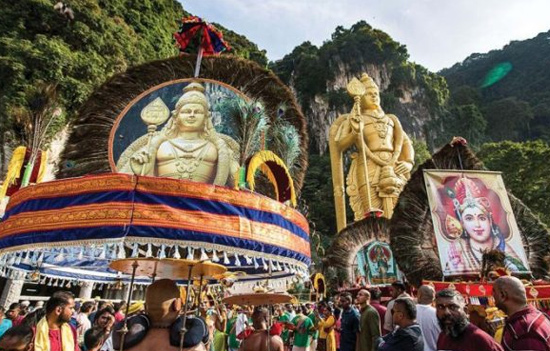 Different images of Lord Murugan at cave entrance. Right in gold colour is Murugan pratima.
Different images of Lord Murugan at cave entrance. Right in gold colour is Murugan pratima. Full caption - Devotees carry Kavadi during their Thaipusam pilgrimages which are adorned with peacock feathers of Mayil, Murugun’s vihana.
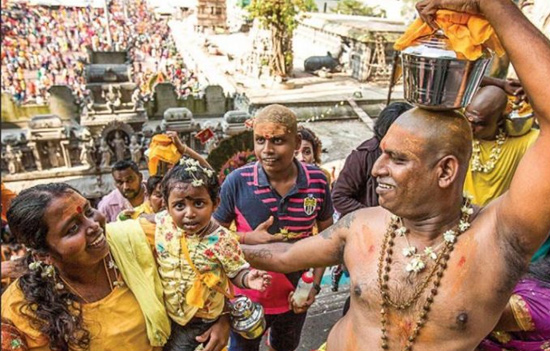 A
pilgrim carrying a paal kavadi (a milk pot) helps a woman and her child up the
crowded stairs.
A
pilgrim carrying a paal kavadi (a milk pot) helps a woman and her child up the
crowded stairs.While religious life at Batu Caves is continuous, with
daily prayers and a steady stream of devotees and visitors, Thaipusam is
indisputably the dominant festival of the year, annually drawing around one
million people.
For this special event, Lord Murugan’s power center is moved from His main temple—Sri Maha Mariamman in central Kuala Lumpur—to this iconic Batu Caves outpost. The God is conveyed in a silver chariot with His two consorts, Valli and Devayani, attended by priests and followed by officials, musicians and thousands of Hindus from all social backgrounds. For the 2018 Thaipusam, a golden chariot was added to the procession, transporting the murti of Lord Vinayaga (Ganesha), Murugan’s sibling, who also has a temple at Batu Caves.
The chariot was built specially for the Vinayaga Chaturthi festival last year at a cost of RM5 million (US1.27 million). “The golden chariot will be taken in the procession to enable the Hindu community in the city to see it, because public donations were received to make it,” declared Tan Sri R. Nadarajah, chairman of
Sri Maha Mariamman Temple.
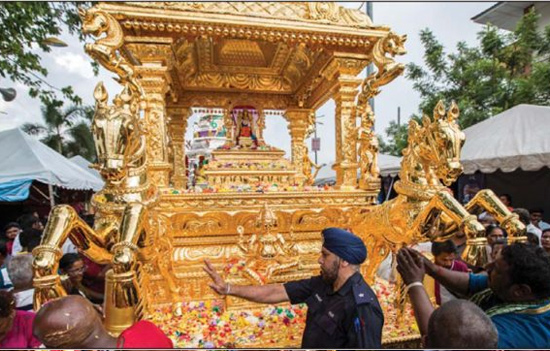 A Malaysian Police officer guards the Golden Chariot, transporting the murti of Lord Vinayagar.
A Malaysian Police officer guards the Golden Chariot, transporting the murti of Lord Vinayagar.
During the 18-hour journey from the center of Kuala
Lumpur to Batu Caves, the procession stops at several Hindu temples, where
offerings are made to the two Gods. Once at Batu Caves, the murtis of Murugan and
His consorts are installed at the Sri Subramaniam Temple, while the holy Vel is
transported up to the shrine in the main cave. As the God is installed in His
lofty abode, the temple flag is raised and Thaipusam officially begins. For the
next 24 hours, devotees arrive in droves to carry kavadi, fulfilling vows to
beseach the blessings of Murugan.
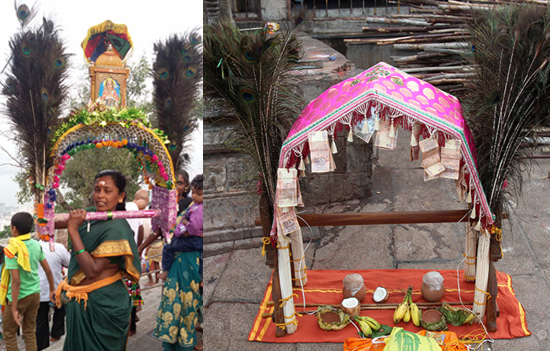 Kavadi at Murugan Temple, Palani Tamil Nadu. 2016
Kavadi at Murugan Temple, Palani Tamil Nadu. 2016
Kavadi bearing at Thaipusam
The power and presence of Murugan at Batu Caves can be
felt throughout the three-day event. Thousands of devotees bear various types
of kavadi to the main shrine inside the caves. Participants are often overtaken
by trance, a divine state known as arul vaku (trance of grace), as the energies
of the Deity flow through them. Entranced penitents appear to have transcendent
powers, enabling them to pierce their flesh with hooks, spears and vels without
feeling pain, and many without bleeding. The experience of the pilgrimage and
the encounter of the God is shared with family and friends.
Kavadi worship at Thaipusam is rooted in Murugan’s legendary renunciation as Lord Dandayudhapani, and in the story of Idumban, who is transformed by his encounter with Lord Murugan while the former was carrying two hills from the north to the South of India. Kavadi is a popular form of worship in South India, especially in Tamil Nadu and Kerala, and the Malaysian kavadi traditions closely resemble those of India.
Many devotees carry kavadi as a vow several years in a row or periodically throughout their lives, appealing to the divine power of Lord Murugan for help in solving personal or family problems. Blessings sought for good health, prosperity, success in occupation, studies, having a baby or resolving family conflicts. Often devotees start to bear offerings for Lord Murugan from their teenage years—in the beginning to fulfil specific vows, but over the years as an integral part of their spiritual practice.
Puravindra, a trade business owner, has carried kavadi for the last 12 years. “I have been devoted to Lord Murugan since I was a child. I was fascinated by the unique way devotees show their love for Lord Murugan, especially on Thaipusam. It started as a vow for studies at the age of 16, the first time I carried a kavadi. Over the years, I have been carrying many different types of kavadi, including piercings on the body. The earlier vows were for specific wishes, then it went on to evolve into pure love and devotion towards Lord Murugan.”
Pilgrims begin preparing for their journey a few weeks before Thaipusam, going on a fast and generally disconnecting from everyday life, seeking inner peace and balance in preparation for their pilgrimage. Murali, who has participated in the pilgrimage with his family since childhood, tells me: “I do fasting for 48 days, taking one vegetarian meal per day. The fasting also includes doing no harm to any living thing. Daily prayers are a key component during this time. I believe fasting helps us concentrate on our objective, which is to carry the kavadi successfully at the end of the fasting period. In my case, my family, initially my mother and now my wife, fast along with me.”
These weeks of fasting, in which devotees have
endured privations, purified and balanced their inner selves, have prepared
them for their encounter with the Divine. Accompanied by family and friends,
kavadi bearers take a padayatra (pilgrimage by foot) of several kilometers, to
the banks of a nearby river and up the 272 steps to the altar in the main
cavern, bearing offerings to Lord Murugan, thus fulfilling personal vows.
Upon arriving at the Batu Caves, the pilgrims hold
final preparation rituals on the riverbank. They
have their head shaved and take a purifying bath. “We do puja before carrying the kavadi. In this ritual we offer food and fruits, and pray to the kavadi itself before carrying it,” explains Puravindra.
Then, guided by their spiritual mentors, votaries
often enter a trance, in which Lord Murugan connects with them, lending vigor
to help them fulfill their penance. Once the trance is established, vels or
hooks are inserted in the skin of the devotee. Finally, the kavadi is fitted
and the devotees depart amid the singing of bhajans.
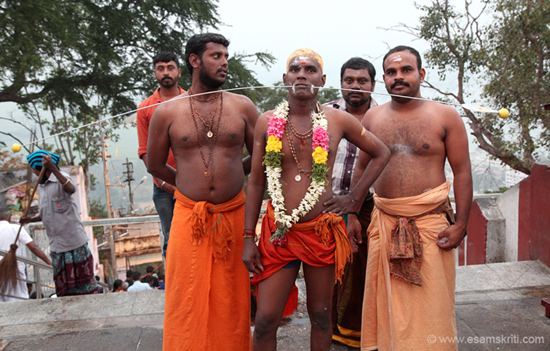 Devotees at Murugan Temple Palani, Tamil Nadu 2016.
Devotees at Murugan Temple Palani, Tamil Nadu 2016.
On their way to the shrine inside the main cave,
pilgrims often stop to perform the kavadi attam, a dance mimicking the swaying
movements of Idumban, who mythically carried the Sivagiri and Sakthigiri hills
to South India as his kavadi. The energetic movements of the dance to bhajan
rhythms, the bearing of kavadi that can weigh up to 200 pounds, and the wearing
of vels and hooks through the skin all reinforce the feeling that the devotees
are in a direct connection to Murugan.
On their journey, the votaries are closely followed and guided. “It’s not possible to complete this pilgrimage without the support of close family and friends. The very first part is learning from them about the strict rules of fasting prior to the pilgrimage, the dos and don’ts. They participate in the prayers held at home prior to the pilgrimage. Most of my friends and family also observe a vegetarian diet, keeping them feeling pure. To them, my journey is their journey, too. I’m blessed to play a small role in bringing my family and friends closer to Lord Muruga,” explains Puravindra.
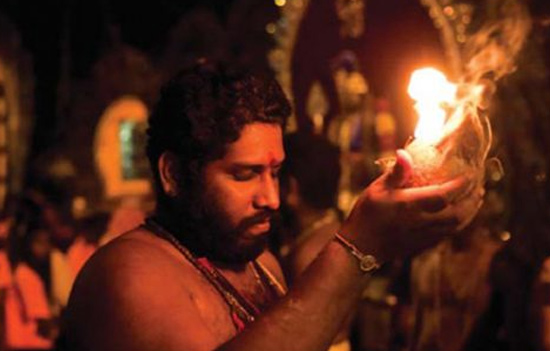 priest performs prayers during the event.
priest performs prayers during the event.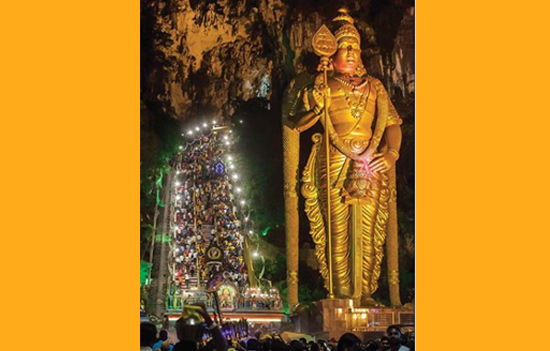 The 140-foot statue of Lord Murugan stands next to the entrance to the Batu Caves temple. A constant flow of pilgrims climb the 272 stairs leading to the entrance.
The 140-foot statue of Lord Murugan stands next to the entrance to the Batu Caves temple. A constant flow of pilgrims climb the 272 stairs leading to the entrance.
As devotees reach the cave shrine, their offerings
are delivered to Lord Murugan. The ritual milk pots carried by devotees are
poured over the Deity. Fruits and flowers are also offered. Each devotee is
released from their trance by a temple priest who applies holy ash on the
forehead of the votary while chanting mantras.
Emerging from their trance, devotees suddenly realize
how exhausted they are from bearing the kavadi. Some devotees actually collapse
and are slowly brought to a normal state by loved ones.
While the pilgrimage at Thaipusam impacts the devotees physically and psychologically, for many the effects are long lasting and deeply impactful to the spiritual shaping of their lives. Murali narrates from his life: “I started at age 12, and for the last 32 years I have carried different types of kavadi. I began with the paal kudam (milk-pot) kavadi. Then I had a peacock kavadi. Then for years I carried small paal kudams on hooks on my back while wearing nail shoes. Finally, I decided it was time for Idumban kavadi, as my age is catching up with me, and I would like to continue this practice for the rest of my life. My parents and my family have always been my strongest motivation in carrying kavadi, along with the blessings of Lord Muruga.”
Conclusion
Murugan’s annual visit to Batu Caves on Thaipusam is a period of high spiritual energy which infuses the temple, caves and surroundings with His grace. People from all social strata undertake the pilgrimage, put themselves in the hands of a greater power and in the process succeed in conquering their ego, anger, lust, greed or hatred. The entire Malaysian Hindu community is brought together in honoring Lord Murugan.
This article was first published in Hinduism Today
and Here eSamskriti has obtained permission from
Hinduism Today to share. All Batu Caves pictures are courtesy author.
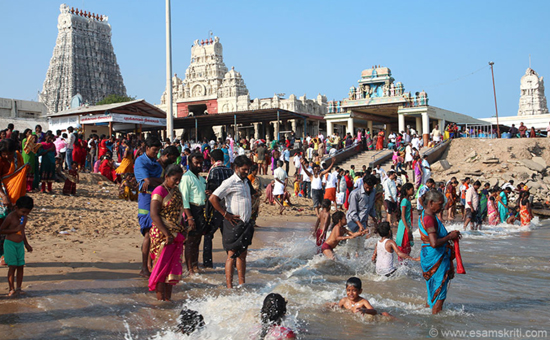 Murugun Temple at Tiruchendur, South India.
Murugun Temple at Tiruchendur, South India.
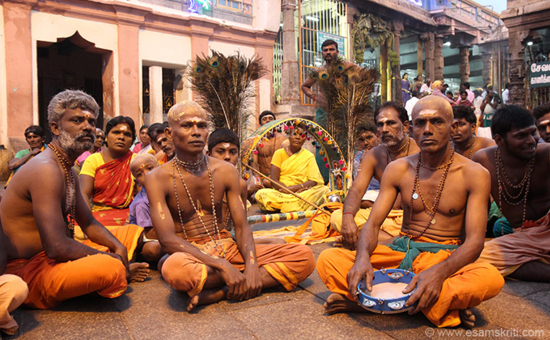 Devotees at Palani, a key temple in South India.
Devotees at Palani, a key temple in South India.
To see
pictures of Murugan Temples at
1. Palani
2. Madurai
3. Tiruchendur
4. Thaipusam
celebrations in Singapore
5. Batu
Caves